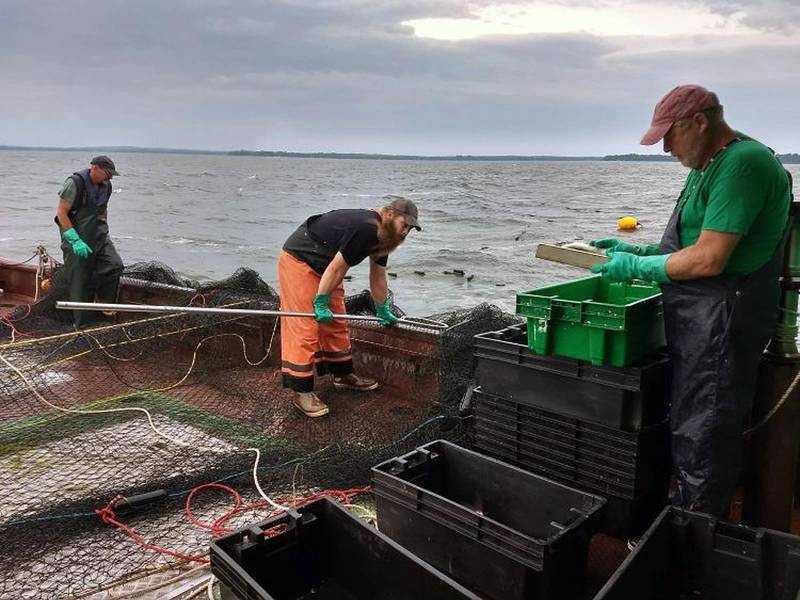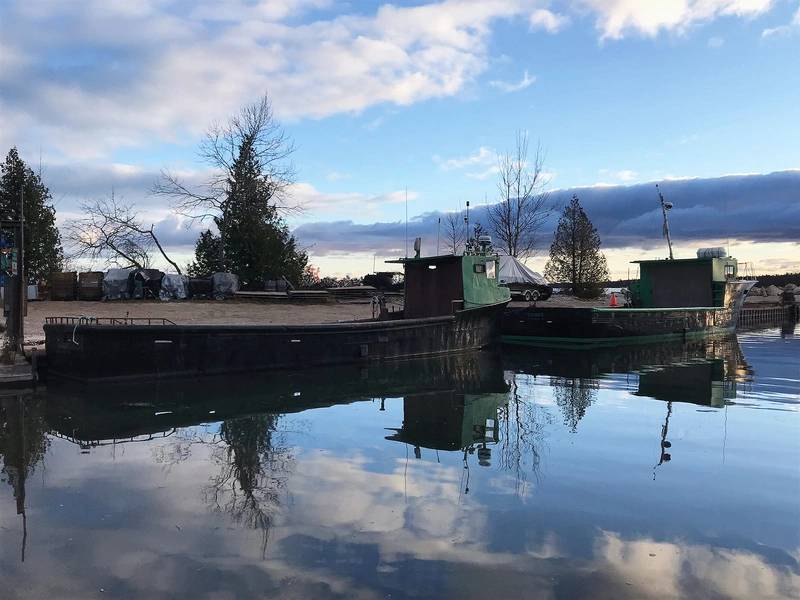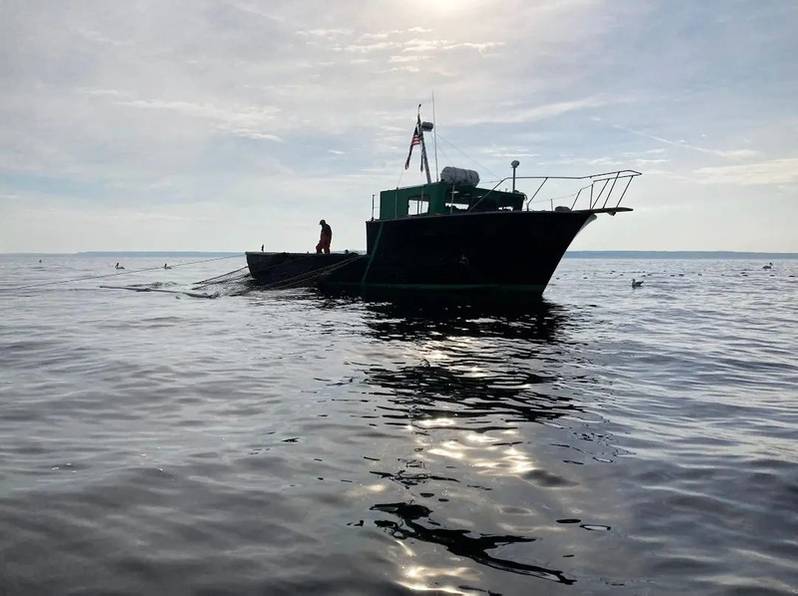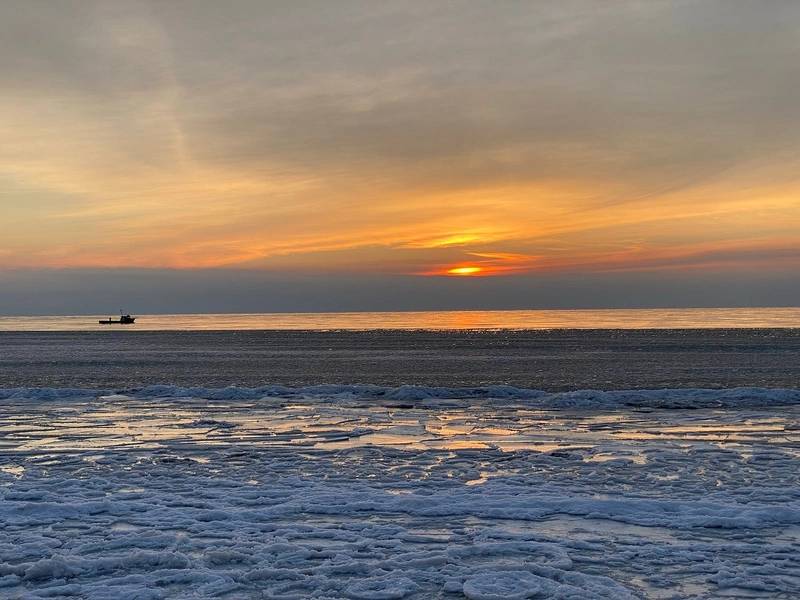Commercial Fishing on the Great Lakes is a Family Affair
Although the number of fishermen who make a living on the waters of the Great Lakes is much diminished from a half century ago, the region's commercial whitefish fishery continues to be viable and profitable.
Henriksen Fisheries is one of about a dozen commercial entities in the Wisconsin waters of Lake Michigan, focused on trap netting whitefish in Green Bay and the waters surrounding the Door Peninsula.
Charlie Henriksen started his family-owned fishing business in Door County in 1987.
Originally from Illinois, the Henriksen family enjoyed vacations in Door County, and eventually bought a hotel on the peninsula and became year-round residents. Charlie was enticed into joining friends fishing on the water, and it eventually became his full-time vocation. In 1989 he purchased his first boat.
There is a year-round demand, but summer and the autumn foliage seasons are when the peninsula is packed with vacationers. "We're licensed for 30 nets, but we only have eight in the water right now, Henriksen said. "We need to catch the fish when the restaurants want the fish."
Whatever he doesn't sell locally, he has standing orders from brokers in Chicago and Ontario that will take whatever he can sell them.
 Lake whitefish are harvested from a trap net in Wisconsin's Bay of Green Bay in Lake Michigan. Todd Henriksen scoops fish from the net, while Charlie Henriksen measures fish to ensure they are at least 17-inches long. (Photo: Titus Seilheimer, Wisconsin Sea Grant)
Lake whitefish are harvested from a trap net in Wisconsin's Bay of Green Bay in Lake Michigan. Todd Henriksen scoops fish from the net, while Charlie Henriksen measures fish to ensure they are at least 17-inches long. (Photo: Titus Seilheimer, Wisconsin Sea Grant)
Today the operation includes two boats, the 40-foot Karen, and 43-foot Roamer. Henriksen's boats are based at Sand Bay, and the company recently opened a new processing, storage and retail facility in nearby Ellison Bay, Wis.
The Karen was built as a trap net boat in Ohio in 1956. Rebuilt and repowered twice, Henriksen said she served them well for many years. His second boat was originally a 1969 three-cabin Chris-Craft "Roamer".
The Chris-Craft company had been making its classic boat designs for a century. The boats were originally made of wood, such as mahogany and teak. In 1955 the first fiberglass models came off the production line, and metal boats were offered by the company's Roamer Steel Boats Division upon its purchase of the Roamer Boat Company in 1957. Those steel hulls were known as Chris-Craft Roamers.
He purchased the boat in 2011 in Chesapeake City, Md., and hauled it back to Door County. It was in poor shape, and underwent a major transformation, reconfiguring the drive train to a single screw and cutting the cabin back to create maximum deck space for haling the nets. Power comes from a Cummins M-11 diesel. Even after the "chop job," the elegant cabin cruiser lines are still evident.

Karen and Roamer are moored together at Sand Bay, Wis. (Photo: Henriksen Fisheries)
Whitefish are primarily harvested using trap nets, which are up to 500 feet wide and create a cylinder about 40-feet deep. They are completely submerged, at least 16 feet below the surface, and are marked with buoys distinctive to the respective fishermen. They are anchored to the bottom with about 1,000 feet of poly line.
I joined the crew of the Roamer on Green Bay on a morning in May. During my outing we pulled three trap nets. On some days the crew might pull five or six. The nets are winched up partially out of the water and pulled over the deck so the fish can be scooped out of the traps with long-handled nets.
Charlie Henriksen uses a gauge to make sure the fish meet the 17-inch minimum. Those that are two small are tossed back in the lake. The fish are kept alive in the nets until harvesting. They not only remain as fresh as possible for market, but discarded fish such as sub-legal sized fish or game fish like walleye can be safely returned to the water.
The whitefish are placed in plastic bins, with each one holding about 100 pounds of fish. After the nets are emptied, they're lowered back into place, and the bins of fish are covered with ice.
According to Charlie's son, Will, a good net is 500 to 600 pounds, and a good day's haul is 2,000 to 3,000 pounds. "Sometimes we'll catch 1,500 pounds in each net."
The biggest hauls come in the autumn, said Will. "We might catch a third of our year's catch in October."
 Wisconsin fishermen use trap nets to catch whitefish. The nets are designed to catch whitefish and allow other non-target species to be released unharmed. (Photo: Henriksen Fisheries)
Wisconsin fishermen use trap nets to catch whitefish. The nets are designed to catch whitefish and allow other non-target species to be released unharmed. (Photo: Henriksen Fisheries)
On the day in May when I joined them on Roamer, they weren't so lucky. The three nets produced a total of 500 pounds of whitefish, along with a number of throwbacks, including a few dozen walleye and one lake sturgeon that were returned to the water.
It's a labor-intensive job, and good help is hard to come by. The county has helped local businesses navigate the work visa programs, and Henriksen has sponsored experienced fisherman from El Salvador to come and work for his company, and he said he couldn't get by without them.
Dynamic fishery
In addition to whitefish, there used to be flourishing Great Lakes fisheries for lake trout, chub, smelt and yellow perch, but their numbers have declined. Declines in fish populations were often the result of overfishing in the past. Today, however, the driving force behind fish stocks in the Great Lakes are invasive species. According to the Michigan Department of Natural Resources, "Changes in Great Lake productivity due to invasive species like quagga and zebra mussels are believed to be behind the declines in these popular commercial species."
Invasive fish species like the lamprey, goby and alewife have greatly impacted native species. Pacific salmon were introduced to create a new fishery and help control invasive fish like the alewife. Today, native brown and lake trout, as well as whitefish, are finding the goby to be a food source.
In recent years, industrial pollution has been controlled, and PCB clean-up for waterways like the Fox River, which empties into Green Bay, has restored water quality and thus fish reproduction. And, in an odd twist, the invasive mussels have filtered out impurities and pollutants in the water so Green Bay is clearer than anyone has seen in generations.
Fishing success can vary like the Wisconsin weather. Henriksen came to realize that his success was linked with all the other fisherman on the lake, and that was dependent on the heath of the lake and its ecosystem. He became involved in what he refers to as "fish politics." He served for three decades as president of the Wisconsin Commercial Fisheries Association, and has been a constant and passionate advocate for the industry in local, state, and regional politics. He also is a member and current chair of the Lake Michigan Commercial Fishing Board. Charlie was a founding member of the Wisconsin Invasive Species Council, created in 2002 under the auspices of the Wisconsin Department of Natural Resources DNR). He also works with the Wisconsin Cooperative Fishery Research Unit, a cooperation between the U.S. Geological Survey, the Wisconsin DNR, and the University of Wisconsin-Stevens Point College of Natural Resources.
While whitefish stocks remain plentiful in certain parts of the Great Lakes, they have disappeared from other areas within their native range. But, Henriksen said the whitefish has proven to be adaptable. "They've changed where they are, and what they eat. The guys I fished with 30 years ago wouldn't believe where we're catching fish today."
 Henriksen Fisheries' two boats are based at Sister Bay, Wis., where ice can be prevalent in colder months. (Photo: Henriksen Fisheries)
Henriksen Fisheries' two boats are based at Sister Bay, Wis., where ice can be prevalent in colder months. (Photo: Henriksen Fisheries)
Family business
Traditionally, Great Lakes commercial fishing is a family affair, with the business (and the licenses) passed down from one generation to the next.
According to the Henriksen website, the catch is processed and delivered locally and beyond by generational owners and team members, focused on a sustainable fishery. Even the fish offal from their processing facility is forwarded to local farmers to compost for community agriculture. "We are all part of a producer-driven, community-supported food system that offers a year-round product inventory, creates jobs, and preserves the commercial fisherman heritage. From net to plate, there is no middleman, there is just proud fisherman doing what they love."
The main markets for the fresh-caught whitefish are local restaurants and smokehouses in and throughout Door County and Wisconsin. Henriksen Fisheries regularly supplies 27 restaurants throughout the year, and many of them are family-owned.
When the supply is available, he has standing orders from brokers in Chicago and Ontario that will buy his fish.
Henriksen's son, Will, has grown up in the business and today is Charlie's "first mate." He will inherit the company.
Will's wife, Kristie, has also joined the business, and helped to keep the business viable through the pandemic when many restaurants were closed. She makes dips, spreads and fishcakes that are sold at local farm markets, food festivals and other Door County family businesses. She hopes to expand to new retail markets.
Charlie Henriksen has seen the bay and the fishery change over the past four decades. But he's optimistic. The efforts to control the invasive species is making progress, the whitefish population is healthy, and the family business is expanding.
Son Will agrees. "As long as the fishery holds out, this is what I'm going to do."
















